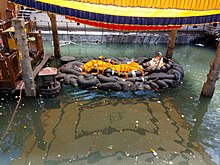Budhanilkantha Temple
This article needs additional citations for verification. (August 2015) |
| Budhanilkantha Temple | |
|---|---|
बुढानिलकण्ठ मन्दिर | |
 | |
| Religion | |
| Affiliation | Hinduism |
| District | Kathmandu |
| Location | |
| Location | Budanilkantha |
| Country | Nepal |

Budhanilkantha Temple, located in Budhanilkantha, Nepal, (Nepali: बुढानिलकण्ठ मन्दिर; translation: Old Blue Throat) is a Hindu open air temple dedicated to Lord Mahavishnu. Budhanilkantha Temple is situated below the Shivapuri Hill at the northern end of the Kathmandu valley.[1] and can be identified by a large reclining statue of Lord Mahavishnu. The temple's main statue of Budhanilkantha is considered the largest stone carving in Nepal.[2]


Location[]
Budhanilkantha temple, also known as the Narayanthan Temple, is situated in Kathmandu. Though the temple is named Budhanilkantha, its name does not come from the Buddha; Budhanilkantha stands instead for “Old Blue Throat”. The statue symbolizes Lord Vishnu, who is regarded as one of the 'Trimurtis', along with Brahma and Shiva.
Deity[]
The main statue is a black stone structure carved from a single block of black basalt. The statue stands 5 meters tall (around 16.4 feet) and is positioned in the middle of a recessed pool of water, which is 13 meters (42.65 feet) long. It depicts the deity reclining on the coils of the cosmic serpent Shesha. He holds the Sudarshana Chakra, Club, a Conch Shell and a gem in his four hands. He is well adorned with a crown engraved with multiple Kirtimukha images which can often be seen being overlapped by a silver crown. This temple is regarded as a sacred place for Hindus but equally well venerated by Buddhists which is an excellent example of religious harmony in Nepal.
Origin of the statue[]
According to one story, a farmer and his wife once struck a figure while plowing the field, which caused it to start soaking blood into the ground. This turned out to be the figure of the lost deity of Budhanilkantha, which was recovered and placed in its present position.
Another legend states that the statue was sculpted and brought to its current location in Kathmandu during the reign of the seventh-century monarch Bishnugupta, who controlled the Kathmandu Valley under the Lichchhavi king Bhimarjuna Dev.

It was suggested for many years that the statue floats in the pool. Indeed, limited access to scientific rigour in 1957 failed to confirm or refute the claim but a small chip of the statue did confirm it to be silica-based stone but with a remarkably low density similar to lava rock.
The Floating statue continues to fascinate and the number of subsequent requests for access to study its physical nature have been declined.
Festivals[]
The Budhanilkantha Temple has become the site where Haribondhini Ekadashi Mela takes place on the 11th day of the Hindu month of Kartika (October–November). Attended by thousands of pilgrims, it is the temple's principal festival in celebration of the awakening of Lord Vishnu from his long sleep.[3]
The Legend of the Nepal Monarchy[]
A legend states that King Pratap Malla (1641–1674) had a prophetic vision. This vision resulted in him believing that the kings of Nepal would die if they visited the Budhanilkantha Temple. Nepali monarchs after King Pratap Malla have never visited the Temple in fear of the prophecy.[4]
See also[]
References[]
- ^ "Ministry of Culture, Tourism and Civil Aviation - Government of Nepal". www.tourism.gov.np. Retrieved 2016-07-31.
- ^ "Budhanilkantha, Nepal - Lonely Planet". lonelyplanet.com. Retrieved 2015-09-14.
- ^ "Budhanilkantha". sacredsites.com. Retrieved 2015-09-14.
- ^ "Budhanilkantha". Places of Peace and Power.
| Wikimedia Commons has media related to Budhanilkantha Temple. |
- Hindu temples in Kathmandu District
- Kathmandu District
- Vishnu temples in Nepal